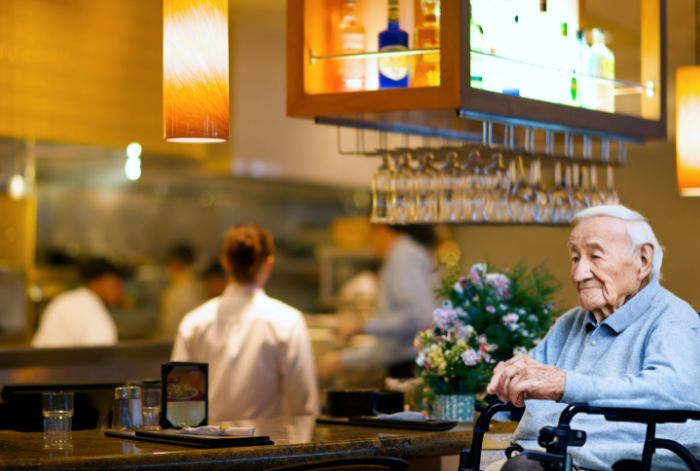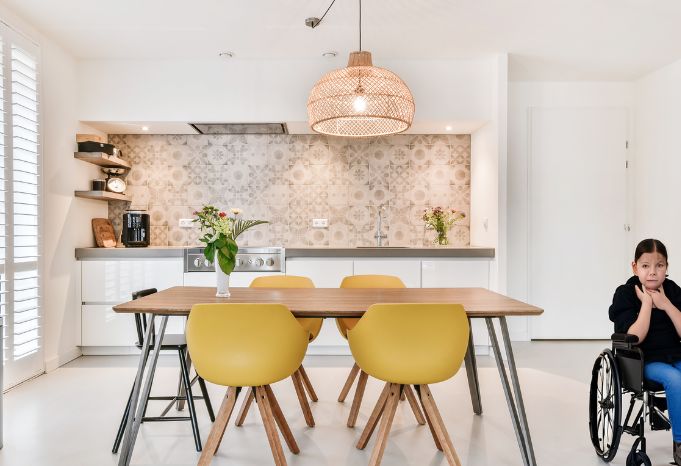In the grand ballet of daily life, the dining room serves as a stage where friends and family pirouette around the table, swirling in a waltz of laughter, conversation, and shared meals. But for wheelchair users, this seemingly effortless dance is punctuated by hurdles and obstacles, transforming the dining room bereft of inclusivity for mobility-challenged loved ones. With tables like towering fortresses, pathways like narrow canyons, and lighting like dimly lit caverns, the dining room becomes a battleground where people with disabilities must navigate the unyielding terrain in their quest for comfort, accessibility, and inclusion.
Making a dining room wheelchair friendly involves considering accessibility, comfort, and ease of use for wheelchair users. Here are some suggestions to help you create a wheelchair-friendly dining room:
- Accessible entryways: Ensure that the entrances to the dining room are wide enough to accommodate a wheelchair, typically at least 32 inches (81 cm) wide. If necessary, consider widening doorways or installing swing-clear hinges.
- Adequate space: Allow wheelchair users to maneuver easily within the dining room. Allow a turning radius of at least 60 inches (152 cm) for a wheelchair to turn around comfortably.
- Smooth flooring: Choose materials that allow for easy wheelchair movements, such as hardwood, laminate, or low-pile carpet. Avoid thick, plush carpets or uneven surfaces, which impede wheelchair mobility.
- Appropriate table height: Select a dining table with a proper level for wheelchair users, typically around 28-34 inches (71-86 cm) from the floor to the tabletop. Ensure enough knee clearance under the table, ideally around 27-29 inches (68-74 cm) of vertical space.
- Accessible seating: Provide at least one accessible seating area for a wheelchair user. This could be a designated spot at the table without a fixed chair, allowing the wheelchair user to position themselves comfortably. Alternatively, consider using a wheelchair-accessible dining chair with adjustable height and removable armrests.
- Clear pathways: Keep the paths in the dining room free of obstacles and clutter, making it easier for wheelchair users to navigate the space.
- Proper lighting: Ensure adequate lighting in the dining room so that wheelchair users can see clearly and navigate the space safely. Consider using a mix of ambient, task, and accent lighting for optimal visibility.
- Accessible storage: Provide storage options that are easy for wheelchair users to reach, such as lower cabinets, open shelves, or pull-out drawers at an accessible height.
- Simple controls: If you have any electronic devices or controls in the dining room, such as light switches or window blinds, ensure they are at a height that is easily accessible for wheelchair users, typically around 42 inches (107 cm) from the floor.
- Inclusive design: Overall, aim for an inclusive and comfortable design for all users, not just wheelchair users. This will create a welcoming and enjoyable dining environment for everyone.
Remember to consult with the specific wheelchair user(s) using the space, as their needs and preferences may vary.
Understanding the Need for Wheelchair-Accessible Dining Rooms
Navigating through public spaces can be a challenge for those with mobility limitations. And when it comes to dining out, the experience can be even more uncomfortable, especially if the restaurant lacks wheelchair accessibility. It’s important to understand the need for wheelchair-accessible dining rooms to create an inclusive and welcoming environment for all customers. Providing easy access for people with disabilities fosters a sense of community, and it’s not just for customers who use wheelchairs – those with strollers, crutches, or other mobility aids can also benefit. By making accessibility a priority, restaurants can ensure that everyone, regardless of their abilities, can comfortably and safely enjoy a meal out.
Creative Solutions to Make Your Dining Room Accessible For All
Let’s face it: dining rooms aren’t always the most accessible spaces. But that doesn’t mean you must sacrifice style or function for inclusivity. There are a variety of creative solutions that can make your dining room welcoming to everyone, regardless of their mobility limitations or other physical challenges. From installing slip-resistant flooring and adding extra lighting to incorporating wheelchair-friendly furniture and ensuring ample maneuvering room, there are plenty of ways to create a space that is both stylish and accessible. So why not get creative and design a dining room that truly works for everyone? You may inspire others to do the same!
Remodeling Ideas to Transform Your Dining Room
Are you tired of the boring, old look of your dining room? Well, fear not, my friend, because I have some remodeling ideas to transform it into a veritable dining palace! How about adding a touch of whimsy with a chandelier made entirely of wine bottles? Or, if you want to keep it classy, try some bold wallpaper with a quirky animal print. And let’s remember the power of a statement garage door – the perfect way to make the front driveway livelier. So, don’t settle for a snooze-fest of a dining room any longer. Let’s shake things up and have some fun with these remodel ideas!
Making Everyday Mealtimes More Inclusive with Small Changes
Making everyday mealtimes more inclusive doesn’t have to involve big, overwhelming changes. Sometimes, small adjustments can make a world of difference. For example, serving dishes with handles can make it easier for people with limited mobility to help themselves to food. Offering a variety of utensils, including spoons with larger handles, can also make it easier for people with disabilities to eat independently. Additionally, labeling dishes and providing menus in large print or braille can be helpful for people with visual impairments. By making these small changes, you can create a more welcoming and accommodating atmosphere for everyone at the table.
How You Can Show Support for a More Accessible Restaurant Industry
As the world becomes increasingly aware of the importance of accessibility, the restaurant industry must keep up. Fortunately, there are plenty of ways that you, as a customer, can show your support for a more accessible restaurant industry. One simple way is to choose restaurants that already prioritize accessibility. When making reservations or checking out menus online, look for restaurants that indicate they have accessible entrances, restrooms, and seating. Additionally, you can provide feedback to restaurants you visit on how they could improve their accessibility, whether it’s adding more ramps or braille menus. By actively supporting accessibility in the restaurant industry, we can help create a more inclusive dining experience.

Spotlight on Restaurants Already Making an Impact with Wheelchair-Friendly Setups
Having a restaurant that is welcoming to everyone is a goal that any business owner should strive for. However, it can be challenging to achieve. That’s why it’s important to recognize those restaurants that go above and beyond to ensure that their establishments are accessible to those with mobility challenges. From installing aluminum handicap ramps to reconfiguring layouts, the restaurants making positive changes to their setups deserve to be celebrated. By prioritizing accessibility, these restaurants aren’t just creating a more inclusive environment but also showing that they care about their customers and want to provide the best possible experience for everyone who walks through their doors.
In conclusion, making dining rooms accessible for everyone is not only a great way to show support for people with disabilities and provide a more inclusive environment when eating out, but it is also a federal requirement. The Americans with Disabilities Act (ADA) requires all publicly accessible establishments to install wheelchair ramps and make their facilities wheelchair-friendly. Many creative solutions can help business owners abide by these rules while still maintaining the aesthetic of their restaurant. From adding portable ramps and adjustable tables to low-cost remodeling ideas, there are countless ways to create an inviting atmosphere that welcomes everyone. Even simply offering accommodations ahead of time or providing additional accessibility resources at your establishment can make huge differences for those coming to your restaurant for the first time or returning guests who need some accommodations. Whether using DIY tools or calling in professionals, being proactive about dine-in accessibility should always be a priority! Remember, accessibility should not be an afterthought but rather a fundamental goal for all restaurants.


